"Christmas Comet of 2018" (46P/Wirtanen) is visible in the skies now... (PICS)
3 posters
Page 1 of 1
 "Christmas Comet of 2018" (46P/Wirtanen) is visible in the skies now... (PICS)
"Christmas Comet of 2018" (46P/Wirtanen) is visible in the skies now... (PICS)
There's a bright green comet in the sky right now and Sydney is covered in clouds for almost two weeks... so that means you prospectors out there in other locations with clearer skies might have an opportunity to nab a picture or even catch a glimpse of it with your eyes - as it grows much brighter and larger over the next week. Anyone in the goldfields with clear skies has a chance to see it with their eyes at the moment although I found it too faint to make out with my own. It's getting brighter by the day but the clouds have moved in and I'm concerned we'll miss the spectacular view it should make around the 16th December. I think the goldfields to the South and West of Australia will offer a really good view and any prospectors there might want to report in if they can see the Comet or post some pictures if they do. I feel those clean skies away from the cities would offer excellent views. The vertical image below was taken just for this forum because I knew it would translate well at just 800 pixels wide as a taller panorama. Comet Wirtanen is at the top portion. The Pleiades is in the middle and some Bilpin orchid can be seen as the landscape below.
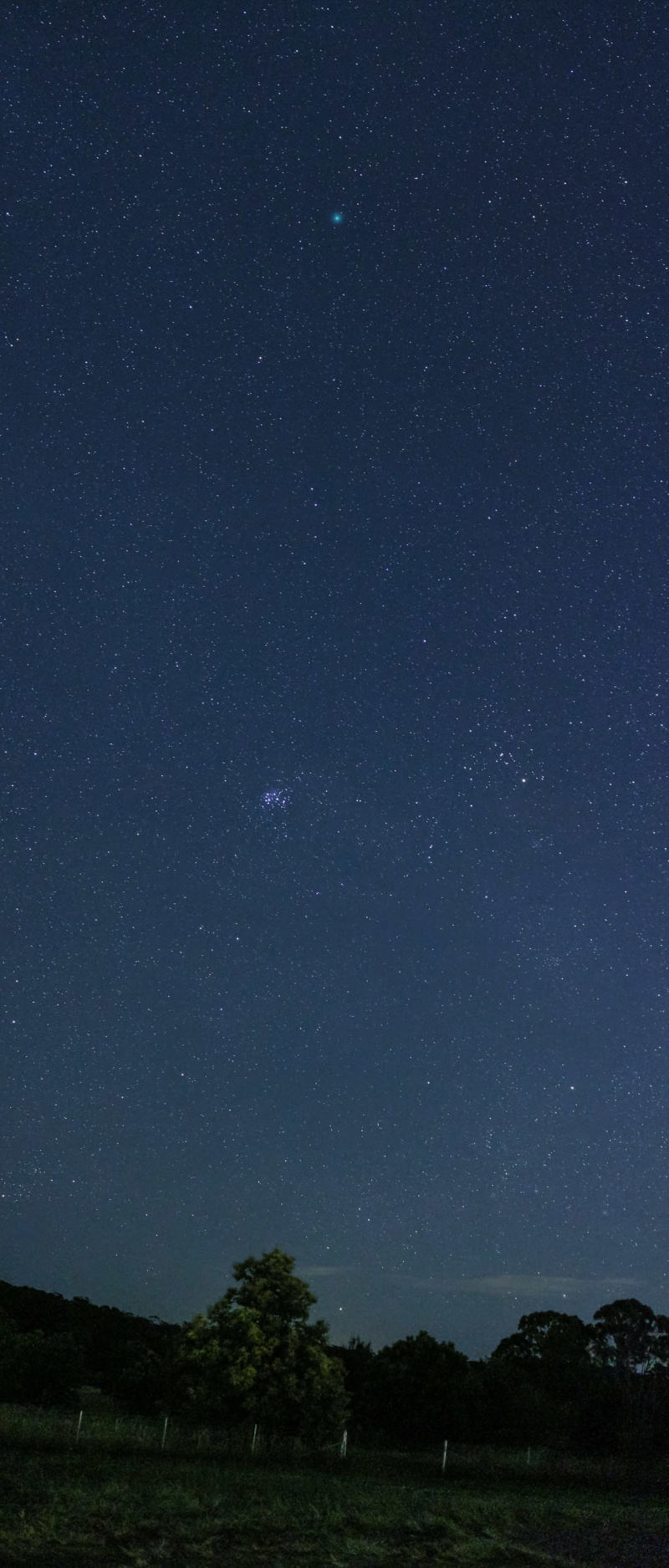
Taken two nights ago - a vertical 3-shot panorama showing the position of Comet 46P/Wirtanen high in the sky over the Pleiades . Taken at Bilpin.
Comet 46P/Wirtanen is presently the diameter of a full moon although the edges are hazy and the tail is only just developing as of a couple of days ago. This is only one of 10 comets to approach this close to Earth since records were kept. It has a bright GREEN color due to the shedding of diatomic carbon in the Coma. It's quite an eerie green too... I drove up to the Sydney Blue Mountains the night before yesterday and figured I'd ignore the weather warnings of overcast conditions. It's good that I did because the skies were clear from one horizon to the other and there were literally hundreds of meteors in the sky at the time. Most were tiny had barely noticeable but every 20 minutes or so a very large one would drop almost all the way to the ground with a bright green glow, releasing white and orange sparks as they faded. When I first stepped out of the car, I counted 5 shooting stars over the Pleiades Constellation in under a second. Magical. These were probably Geminids and the Geminid shower appeared to come to an end at around midnight so I saw no more after that.

By deliberately photographing the stars out of focus, I thought it might show the color of Wirtanen compared to the background stars. It's the green blob.

Two Geminid meteors, one just passed over Comet Wirtanen in the middle of frame.. as my shutter opened.
Now the comet (Wirtanen) wasn't really visible to my eyes. I think it was just barely visible at 4.4 Magnitude but I couldn't quite make out more than a very, very faint smudge in the sky to the North. It's going to be 11.7 million kilometers away at its closest... which is about 30 times the distance from the Earth to the Moon. Wirtanen was discovered in 1948 by American astronomer Carl. A Wirtanen. It is approximately 1.2 kilometers in diameter and completes its orbit every 5.4 years and will next venture this close to our planet in another 20 years. This is the 10th closest pass this comet has made in 70 years.
For those looking to see Comet 46P/Wirtanen (assuming you have clear skies), it will grow brighter until it reaches maximum brightness (3rd Magnitude) on December 16. Then it will slowly drop behind the horizon by December 29 and won't be visible. The best time to view the comet will be between the 14th and 22nd of December. A minor annoyance will be a partial moon in the sky at the time because it may illuminate particles in the air, making it harder to see and photograph the comet. Any camera capable of a 10 to 15 second exposure should do. A bright lens will make things easier to see but only if the moon isn't dominating the night sky.
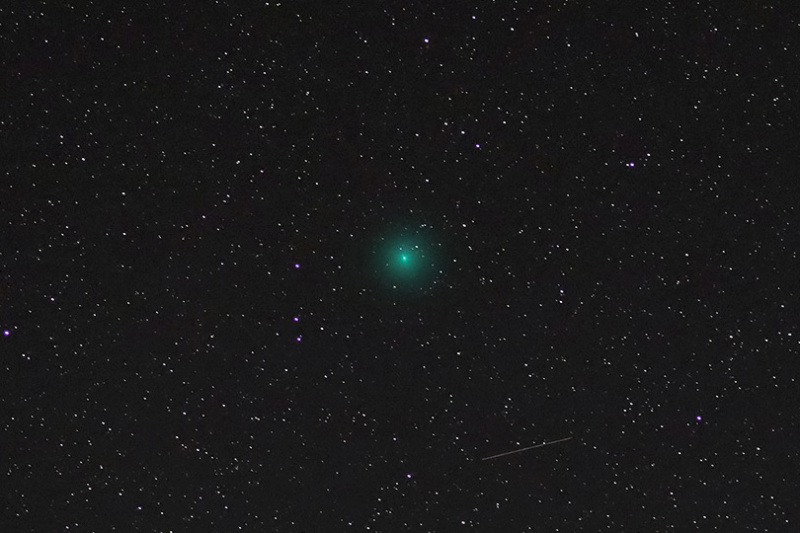
46P/Wirtanen - A cropped image with a satellite passing below the comet.
Watching the weather predictions, it's looking terribly disappointing so far for the big finale. Let's hope the skies clear up over NSW or that someone else has a better view from elsewhere. Just be sure to watch out for getting mosquito repellent on your camera gear because it can cause plastics and rubber gaskets to turn white and degrade. Would be great to see some images from others because each day and location and camera will be different.
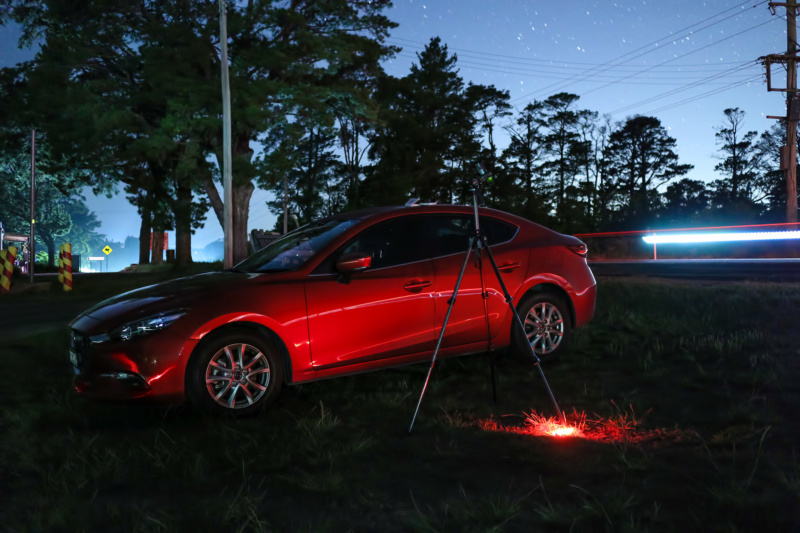
It was a warm night in the mountains for a change. 23C at midnight instead of -3C.
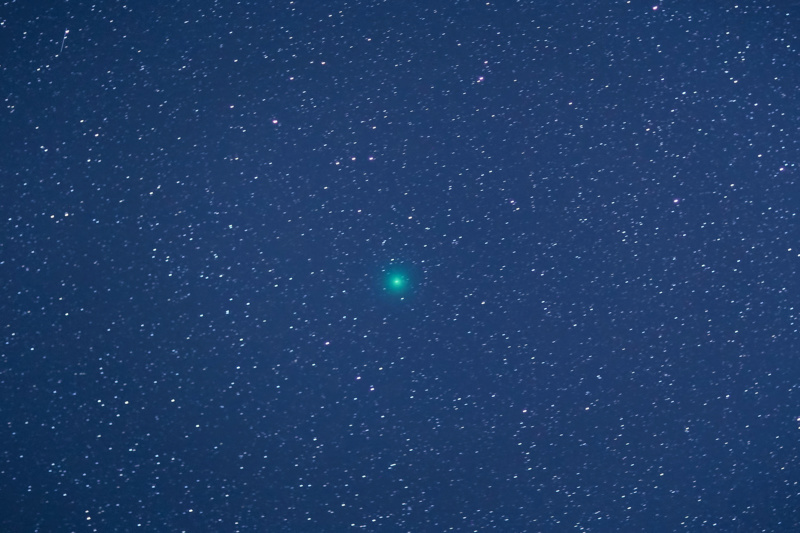
Shot with a Tungsten White Balance... the comet still glows bright green.
In my opinion pretty much any digital camera on a tripod with a 10 to 30 second exposure ability will be capable of capturing the comet, even with a moderately dim lens. A brighter lens of f/2.8 or faster would be better although really fast lenses might need to be stopped down slightly to avoid washing out the pictures. I've seen some shots taken with pocket cameras this week that look quite decent. I used two APSC mirrorless cameras and a Full Frame DSLR with lenses ranging from f/2 to f/1.2 (relatively fast lenses) but I stopped my lenses down a little to f/2.2 and used ISO 1600 to ISO 3600 for my shots. Most exposures were between 8 seconds and 20 seconds long, depending on the focal length of the lens used. A tripod and a flashlight (and mosquito repellent) was all that I needed. My lenses were 22mm to 85mm but if I get a break in the weather I'll reshoot the comet with a 135mm f/2 lens and hopefully will get close with more detail.
As of now, the comet has just formed a thin ion tail which is situated inside the glowing sphere of green gas. It may change shape, it may grow dimmer... but the predictions are that it will become considerably brighter. I'm not expecting to see much of a tail on this comet but it will still look cool to anyone in a dark sky or in the city with a set of binoculars or a small telescope. I still haven't bought one myself although I would like to get something suitable for comet photography someday soon. I'll need to get a decent EQ Mount to track the sky properly for that sort of thing. But in the meanwhile, the shots here are all I can manage. If the skies clear and we get to see it again, it will be closer to the horizon and that makes for more interesting photography.
There's comets in the sky all the time although almost all of them need to be viewed through long exposures with large telescopes. Nothing seems to come close to the super bright Comets we saw in the mid-1990s before quality digital cameras were available commercially. I can remember seeing one (Comet Hyakutake - the Great Comet of 1996) that spanned a good portion of the sky over Hawaii and I could see it out of the corner of my eye even standing under street lights as it spanned a large portion of the sky. That comet won't return for another 70,000 years but it was only discovered a few months earlier the same year as it approached. This gives me hope that we may yet be treated to another such spectacle in our lifetime. Many of the Great Comets in history were only discovered as they entered the Solar System and began to glow. And this still happens today with super-bright comets so there is ALWAYS a chance we'll get to see another with just a few months' notice.
Like Comet Hyakutake, Comet Wirtanen is unusual in that is visible in the night skies rather than in the evening or morning where there are closer to the position of the sun. Whilst it's not going to be as specatular as Comets Hale-Bopp and Hyakutake were, it's an interesting and mysterious visitor that is now visible in our night sky - and it's there for a couple of weeks growing brighter. It is now sometimes referred to as the "Christmas Comet of 2018".
_____________________________________________________________________________

Some links relating to Comet 46P/Wirtanen can be found below:
https://in-the-sky.org/news.php?id=20181213_18_100 (Sydney related link)
https://earthsky.org/space/46p-wirtanen-possibly-visible-to-eye-dec-2018 (general info on the Comet)
http://aerith.net/comet/weekly/current.html (comet update page)
http://www.cometwatch.co.uk/current-observable-comets/ (A list of currently observable comets)
http://spaceweathergallery.com/index.php?PHPSESSID=h5gpmkgbq4ha7sn63disnfbgt5 (Live update images from other astrophotographers).
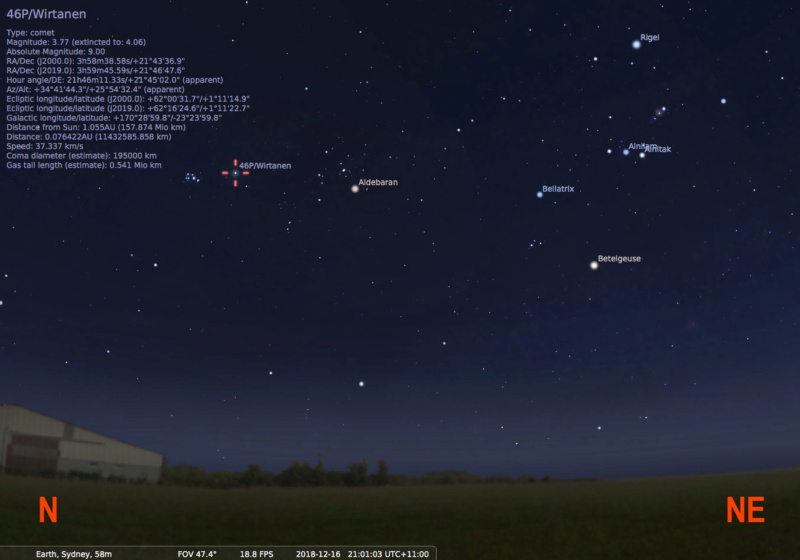
STELLARIUM - showing where Wirtanen will be on the 16th December from Sydney - parked right next to the Pleiades.
_____________________________________________________________________________
During the Australian Gold Rush, the Great Comet of 1861 was actually spotted on May 13 (1961) by John Tebbutt, a young farmer working at the town of Windsor (a well known colonial town near the Hawkesbury River which I drove through to get to Bilpin to take the pictures show above). He observed the faint comet with a handheld brass Marine telescope when it looked like a fuzzy star. It took until May 21 until he noticed enough movement from the comet to identify and conform it for what it was. He sent a letter to the Rev. William Scott, the Government Astronomer at Sydney Observatory as well as a letter to the Sydney Morning Herald. The letter was published on May 25, 1861 on the farmer's 27th Birthday.
Back in this period of time there was no quick method of communication between Australia and the rest of the world so that when the comet became visible in the northern hemisphere on 29 June, it was a complete surprise to the Astronomers in Britain and Europe. John Tebbutt became a famous astronomer and the following 40 years saw him put out so many high quality observations and illustrations on Comets, minor planets, variable stars, eclipses and transits that his one-man observatory in Windsor was regarded as the equal to the government observatories in Sydney and Melbourne. To quote one website: He is rightly judged as having been Australia's foremost amateur astronomer. This comet was visible in the Northern Hemisphere and was even written about in letters from soldiers engaged in the American Civil War.
We can only imagine what the gold prospectors around Australia made of this great comet in the sky that year when it mysteriously appeared over their heads each evening.

Comet C/1881 K1 (also called the 'Great Comet of 1881' and 'Comet Tebbutt', 1881 III, 1881b) is a long-period comet discovered by John Tebbutt on 22 May 1881 at Windsor, NSW.
But John Tebbutt later discovered the Great Comet of 1881 (C/1881 K1) and he spotted that one from his Windsor location as well using just his eyes and later used that same Marine telescope to confirm. I can attest to clear skies nearby as I took my first Milky Way night sky panoramas from just outside the town of Windsor almost 10 years ago. In this instance his own words are more descriptive. In his Astronomical Memoirs in the section entitled 1881, John Tebbutt gave an account of his discovery:
"This year, like 1861, was signalised by the discovery of a great comet. While scanning the western sky with the unassisted eye on the evening of May 22, I discovered just below the constellation Columba a hazy looking object which, from my familiarity with that part of the heavens, I regarded as new. On examining it with the small marine telescope previously referred to in these memoirs, I found it to consist really of three objects, namely, two stars of the 41⁄2 and 51⁄2 magnitude afterwards identified at γ1 and y2 Cæli, and a head of a comet. I could not find any trace of a tail, but on the 25th it exhibited a tail about two degrees in length. Immediately on its discovery I obtained, with the 41⁄2 equatorial, eight good measures of the nucleus from one of the bright stars just mentioned. On the following day I notified the discovery to the Government Observatories at Sydney and Melbourne. A series of filar micrometer comparisons was obtained at Windsor, extending from the date of discovery to June 11, when the comet disappeared from our morning sky and became an object for the northern observatories. … "
This comet was incredibly bright and was visible in the skies from May 1881 to August with the naked eye and disappeared from telescope views around February 1882. There were other Great Comets during the Gold Rush that would have astounded the diggers at the time, including Donati's Comet in October, 1858. And with few distractions and clear views of the night sky, I imagine they'd have been the talk of the day.

Taken two nights ago - a vertical 3-shot panorama showing the position of Comet 46P/Wirtanen high in the sky over the Pleiades . Taken at Bilpin.
Comet 46P/Wirtanen is presently the diameter of a full moon although the edges are hazy and the tail is only just developing as of a couple of days ago. This is only one of 10 comets to approach this close to Earth since records were kept. It has a bright GREEN color due to the shedding of diatomic carbon in the Coma. It's quite an eerie green too... I drove up to the Sydney Blue Mountains the night before yesterday and figured I'd ignore the weather warnings of overcast conditions. It's good that I did because the skies were clear from one horizon to the other and there were literally hundreds of meteors in the sky at the time. Most were tiny had barely noticeable but every 20 minutes or so a very large one would drop almost all the way to the ground with a bright green glow, releasing white and orange sparks as they faded. When I first stepped out of the car, I counted 5 shooting stars over the Pleiades Constellation in under a second. Magical. These were probably Geminids and the Geminid shower appeared to come to an end at around midnight so I saw no more after that.

By deliberately photographing the stars out of focus, I thought it might show the color of Wirtanen compared to the background stars. It's the green blob.

Two Geminid meteors, one just passed over Comet Wirtanen in the middle of frame.. as my shutter opened.
Now the comet (Wirtanen) wasn't really visible to my eyes. I think it was just barely visible at 4.4 Magnitude but I couldn't quite make out more than a very, very faint smudge in the sky to the North. It's going to be 11.7 million kilometers away at its closest... which is about 30 times the distance from the Earth to the Moon. Wirtanen was discovered in 1948 by American astronomer Carl. A Wirtanen. It is approximately 1.2 kilometers in diameter and completes its orbit every 5.4 years and will next venture this close to our planet in another 20 years. This is the 10th closest pass this comet has made in 70 years.
For those looking to see Comet 46P/Wirtanen (assuming you have clear skies), it will grow brighter until it reaches maximum brightness (3rd Magnitude) on December 16. Then it will slowly drop behind the horizon by December 29 and won't be visible. The best time to view the comet will be between the 14th and 22nd of December. A minor annoyance will be a partial moon in the sky at the time because it may illuminate particles in the air, making it harder to see and photograph the comet. Any camera capable of a 10 to 15 second exposure should do. A bright lens will make things easier to see but only if the moon isn't dominating the night sky.

46P/Wirtanen - A cropped image with a satellite passing below the comet.
Watching the weather predictions, it's looking terribly disappointing so far for the big finale. Let's hope the skies clear up over NSW or that someone else has a better view from elsewhere. Just be sure to watch out for getting mosquito repellent on your camera gear because it can cause plastics and rubber gaskets to turn white and degrade. Would be great to see some images from others because each day and location and camera will be different.

It was a warm night in the mountains for a change. 23C at midnight instead of -3C.

Shot with a Tungsten White Balance... the comet still glows bright green.
In my opinion pretty much any digital camera on a tripod with a 10 to 30 second exposure ability will be capable of capturing the comet, even with a moderately dim lens. A brighter lens of f/2.8 or faster would be better although really fast lenses might need to be stopped down slightly to avoid washing out the pictures. I've seen some shots taken with pocket cameras this week that look quite decent. I used two APSC mirrorless cameras and a Full Frame DSLR with lenses ranging from f/2 to f/1.2 (relatively fast lenses) but I stopped my lenses down a little to f/2.2 and used ISO 1600 to ISO 3600 for my shots. Most exposures were between 8 seconds and 20 seconds long, depending on the focal length of the lens used. A tripod and a flashlight (and mosquito repellent) was all that I needed. My lenses were 22mm to 85mm but if I get a break in the weather I'll reshoot the comet with a 135mm f/2 lens and hopefully will get close with more detail.
As of now, the comet has just formed a thin ion tail which is situated inside the glowing sphere of green gas. It may change shape, it may grow dimmer... but the predictions are that it will become considerably brighter. I'm not expecting to see much of a tail on this comet but it will still look cool to anyone in a dark sky or in the city with a set of binoculars or a small telescope. I still haven't bought one myself although I would like to get something suitable for comet photography someday soon. I'll need to get a decent EQ Mount to track the sky properly for that sort of thing. But in the meanwhile, the shots here are all I can manage. If the skies clear and we get to see it again, it will be closer to the horizon and that makes for more interesting photography.
There's comets in the sky all the time although almost all of them need to be viewed through long exposures with large telescopes. Nothing seems to come close to the super bright Comets we saw in the mid-1990s before quality digital cameras were available commercially. I can remember seeing one (Comet Hyakutake - the Great Comet of 1996) that spanned a good portion of the sky over Hawaii and I could see it out of the corner of my eye even standing under street lights as it spanned a large portion of the sky. That comet won't return for another 70,000 years but it was only discovered a few months earlier the same year as it approached. This gives me hope that we may yet be treated to another such spectacle in our lifetime. Many of the Great Comets in history were only discovered as they entered the Solar System and began to glow. And this still happens today with super-bright comets so there is ALWAYS a chance we'll get to see another with just a few months' notice.
Like Comet Hyakutake, Comet Wirtanen is unusual in that is visible in the night skies rather than in the evening or morning where there are closer to the position of the sun. Whilst it's not going to be as specatular as Comets Hale-Bopp and Hyakutake were, it's an interesting and mysterious visitor that is now visible in our night sky - and it's there for a couple of weeks growing brighter. It is now sometimes referred to as the "Christmas Comet of 2018".
_____________________________________________________________________________

Some links relating to Comet 46P/Wirtanen can be found below:
https://in-the-sky.org/news.php?id=20181213_18_100 (Sydney related link)
https://earthsky.org/space/46p-wirtanen-possibly-visible-to-eye-dec-2018 (general info on the Comet)
http://aerith.net/comet/weekly/current.html (comet update page)
http://www.cometwatch.co.uk/current-observable-comets/ (A list of currently observable comets)
http://spaceweathergallery.com/index.php?PHPSESSID=h5gpmkgbq4ha7sn63disnfbgt5 (Live update images from other astrophotographers).

STELLARIUM - showing where Wirtanen will be on the 16th December from Sydney - parked right next to the Pleiades.
_____________________________________________________________________________
During the Australian Gold Rush, the Great Comet of 1861 was actually spotted on May 13 (1961) by John Tebbutt, a young farmer working at the town of Windsor (a well known colonial town near the Hawkesbury River which I drove through to get to Bilpin to take the pictures show above). He observed the faint comet with a handheld brass Marine telescope when it looked like a fuzzy star. It took until May 21 until he noticed enough movement from the comet to identify and conform it for what it was. He sent a letter to the Rev. William Scott, the Government Astronomer at Sydney Observatory as well as a letter to the Sydney Morning Herald. The letter was published on May 25, 1861 on the farmer's 27th Birthday.
Back in this period of time there was no quick method of communication between Australia and the rest of the world so that when the comet became visible in the northern hemisphere on 29 June, it was a complete surprise to the Astronomers in Britain and Europe. John Tebbutt became a famous astronomer and the following 40 years saw him put out so many high quality observations and illustrations on Comets, minor planets, variable stars, eclipses and transits that his one-man observatory in Windsor was regarded as the equal to the government observatories in Sydney and Melbourne. To quote one website: He is rightly judged as having been Australia's foremost amateur astronomer. This comet was visible in the Northern Hemisphere and was even written about in letters from soldiers engaged in the American Civil War.
We can only imagine what the gold prospectors around Australia made of this great comet in the sky that year when it mysteriously appeared over their heads each evening.

Comet C/1881 K1 (also called the 'Great Comet of 1881' and 'Comet Tebbutt', 1881 III, 1881b) is a long-period comet discovered by John Tebbutt on 22 May 1881 at Windsor, NSW.
But John Tebbutt later discovered the Great Comet of 1881 (C/1881 K1) and he spotted that one from his Windsor location as well using just his eyes and later used that same Marine telescope to confirm. I can attest to clear skies nearby as I took my first Milky Way night sky panoramas from just outside the town of Windsor almost 10 years ago. In this instance his own words are more descriptive. In his Astronomical Memoirs in the section entitled 1881, John Tebbutt gave an account of his discovery:
"This year, like 1861, was signalised by the discovery of a great comet. While scanning the western sky with the unassisted eye on the evening of May 22, I discovered just below the constellation Columba a hazy looking object which, from my familiarity with that part of the heavens, I regarded as new. On examining it with the small marine telescope previously referred to in these memoirs, I found it to consist really of three objects, namely, two stars of the 41⁄2 and 51⁄2 magnitude afterwards identified at γ1 and y2 Cæli, and a head of a comet. I could not find any trace of a tail, but on the 25th it exhibited a tail about two degrees in length. Immediately on its discovery I obtained, with the 41⁄2 equatorial, eight good measures of the nucleus from one of the bright stars just mentioned. On the following day I notified the discovery to the Government Observatories at Sydney and Melbourne. A series of filar micrometer comparisons was obtained at Windsor, extending from the date of discovery to June 11, when the comet disappeared from our morning sky and became an object for the northern observatories. … "
This comet was incredibly bright and was visible in the skies from May 1881 to August with the naked eye and disappeared from telescope views around February 1882. There were other Great Comets during the Gold Rush that would have astounded the diggers at the time, including Donati's Comet in October, 1858. And with few distractions and clear views of the night sky, I imagine they'd have been the talk of the day.
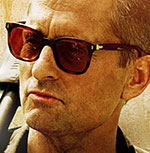
nero_design- Contributor Plus

- Number of posts : 2090
Registration date : 2008-11-18
 Re: "Christmas Comet of 2018" (46P/Wirtanen) is visible in the skies now... (PICS)
Re: "Christmas Comet of 2018" (46P/Wirtanen) is visible in the skies now... (PICS)
awesome article Nero ,I'm more the wiser now,I'll keep my eyes peeled:roll: 
cheers moredeep
cheers moredeep

moredeep- Management
- Number of posts : 1905
Age : 64
Registration date : 2018-05-23

adrian ss- Contributor Plus

- Number of posts : 4434
Age : 78
Registration date : 2015-07-03
 Re: "Christmas Comet of 2018" (46P/Wirtanen) is visible in the skies now... (PICS)
Re: "Christmas Comet of 2018" (46P/Wirtanen) is visible in the skies now... (PICS)
adrian ss wrote:I don't know how you get all of that fine detail Nero, especially with the moon so bright nearby.
All I can get is a total wash out at exp 15 sec, lens 3.5 x 55mm ISO 1800.
At 10 sec I get a darker back ground but no stars visible.
One thing is for certain is that if I had a film in my old Pentax KX and the 135mm x 1.8 Promura lens I would do a hell of a lot better.
The moon wasn't in the sky last week when I took the earlier pictures - as I would have used it to lock the focus on my cameras... but it was there this weekend. And it was very hard to do anything remotely astro with the moon blowing out the otherwise dark skies. I hadn't noticed this before because usually when the moon is in the sky I'll be photographing it and not the Milky Way etc.
That's an incredible shot of McNaught, Adrian! I photographed McNaught from the top of a shopping center but didn't get the wide splash of tail. I could definitely see the brighter area of the tail closest to the Coma but it was still so close to the setting Sun that it was hard to make out any details other than a smudge. I wasn't quite as into astrophotography at the time but I sure am now. I think Comet McNaught was very bright but it was hard to photograph in the afternoon light. Something cool I've come to realize is that many of the really bright comets in recent history have arrived without more than a few months of warning. I really hope we get to see another Great Comet in the skies.
When Comet McNaught came by in 2007, we brought a telescope and our camera up to the rooftop of Castle Towers shopping center and a crowd of people soon turned up although the comet was not easily seen until the sun had set. And when the comet was visible it quickly dropped below some apartment buildings and out of sight. The comet was only visible for a brief time (a couple of days) if I remember correctly. The longer tail (that you caught) developed on the final day in all its majesty. We had some smokey skies back then so it was hard to see much from where we were. I sure wish to see something like that again. There were 21 bright comets in the last Century which totaled about one every 4.8 years. Some were classed as Great Comets I read that a comet needs to be incoming from around the distance of Jupiter before it begins to outgas and become visible to Earth's telescopes... and it then takes about a year before we can view it (if it's bright enough) from our skies. But somewhere out there is a Great Comet that is already inbound so lets hope we get to see one more super bright one in out lifetime. Great Comets (according to the data) come by every 25 to 40 years.

A single unedited image straight from the camera on Monday morning (EOS 6D + 135mm f/2 lens) - taken on Dec 16 at 2am.
Something I did a couple of nights ago was bring a longer lens with a bright aperture. But I could only take 4 second shots before the stars began to show streaks. But I opted for 5 seconds just to get a little more light. I arrived at my location in the Blue Mountains with the moon still in the sky ...and it washed every single picture out that I tried to take. By the time the moon set at about 2am, the comet's location was moving towards the horizon and became less clear. But for one hour I took hundreds of pictures of it to try and stack together when I got home. I'm using a Mac and don't have any decent stacking software for it so I had to manually align the images on top of one another to gradually reveal more detail.

Notice how fast the comet is moving? This was captured over just 15 minutes.
Taken by apollo lasky on December 16, 2018 @ naperville, il - source: SPACEWEATHER.COM
A view of Comet 46P/Wirtanen drifting through space... (Timelapse Video) I suspect this was shot over two nights.
When I arrived I knew I would be dealing with a half moon in the sky and that this would wash out any images until it set. I guess this is because the moonlight illuminates all the particles in the air for many miles over the ground and the cameras pick up on it with long exposures. I could see the Pleiades Constellation clearly and knew the comet was right nearby but I couldn't see anything so faint in the moonlight. I took the image shown below but it was terrible. I had no chance to take anything useful of the night sky until the moon set so I took some images of my gear in use and then put plastic bags over my cameras to stop the dew from forming on the glass or metal. As annoying as it was I had to sit in my car for a while until the moon set. When the half-moon dropped below the treeline the sky grew darker and the stars were much brighter. It was lovely out there in the dark because the temperature was still 27C and it was 2am. I had wisely sprayed myself with Aroguard earlier and the mosquitoes came and went without biting me. I saw no shooting stars although the Geminids were supposed to be active. A few showed up in my pictures but nothing spectacular.
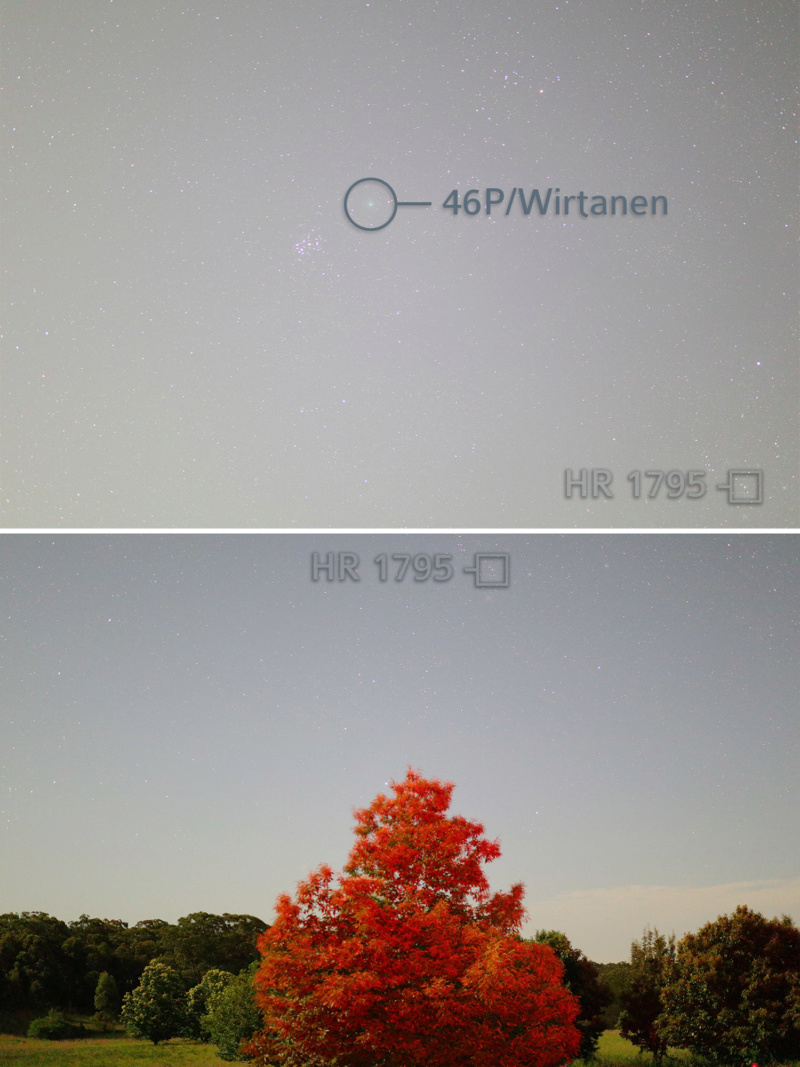
My first shot with the moon still up was a disaster. These were taken at 10:30pm under a half moon.
Killing time in the dark without falling asleep after midnight was a tedious chore and I didn't want to waste my time out there... so I did some experiments with using the moon as a focus target and I took some pictures of the cameras for use elsewhere on a camera forum. I haven't used the EF 135mm f/2L USM lens since the last comets Lovejoy and ISON and PanSTARRS (Comet ISON was a fizzer). But I knew it would offer me some contrast while being a bright enough lens at f/2 to take 4 second exposures without any noticeable star trails. Using the Rule of 500 I calculated that the lens might be capable of a 5 second exposure and so I tried this on Monday morning. Something I grabbed at home at the last moment was a Lens Heater that my wife sourced for me on Ebay. Instead of a Chem Light I brought along a Celestron PowerTank from the Australian Geographic store. It's meant to power a 12 Volt telescope mount but it also contains a red or white LED light panel and two USB ports. I noticed some very "glowy" stars in some shots with my M6 camera so I took a look and sure enough the glass filter was frosted up. I plugged in the USB lens heater and the lens cleared up without any problems.
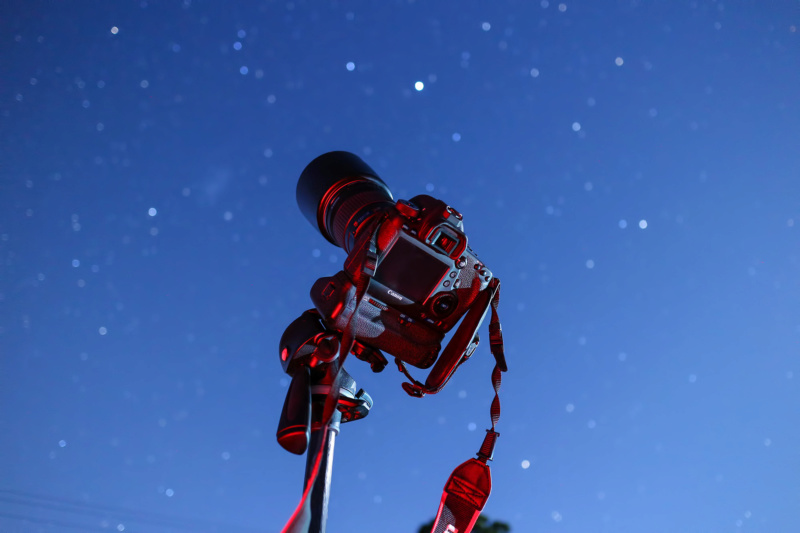
Waiting for the moon to set. It made the sky far too bright for any astrophotography to I took some 'gearshots'.
This is the EOS 6D with the EF 135mm f/2 USM lens - as viewed by the EOS M + EF-M 11-22mm f/4-5.6 IS STM lens.

Moonlight washing out the sky from one horizon to the other - until it set.
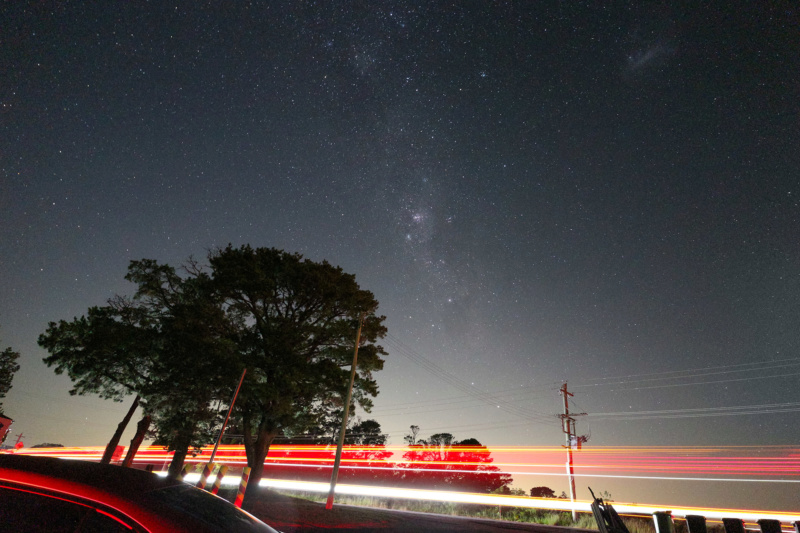
Looking South towards the Coalsack Nebula with trucks lighting up the foreground (EOS M + EF-M 11-22mm f/4-5.6 IS STM lens).
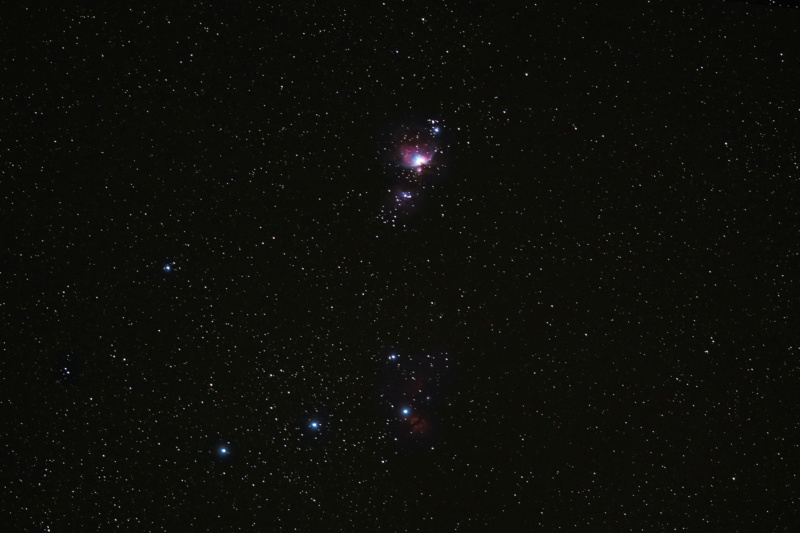
Orion Nebula with the 135mm f/2 lens. (around 30 manually stacked images) - EOS 6D + EF 135mm f/2L USM lens
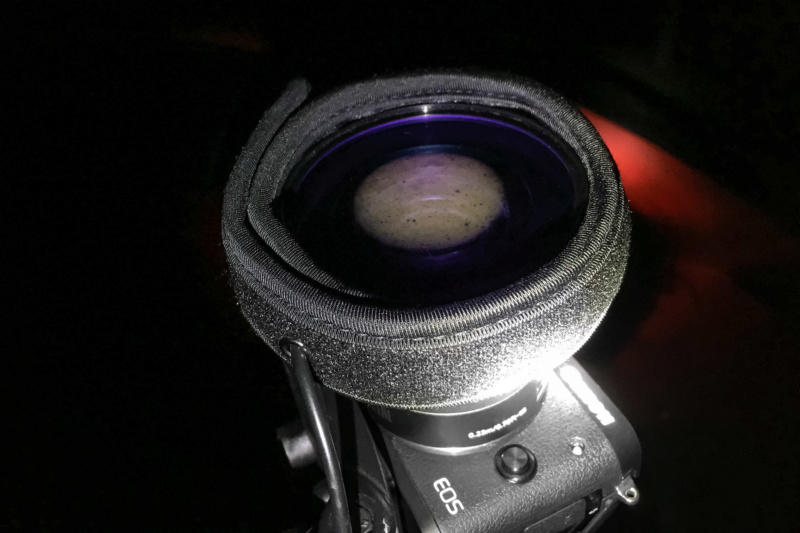
A $40 Lens Heater (USB powered) from Ebay - reducing the dew on my NiSi Night Filter which frosted up a little.
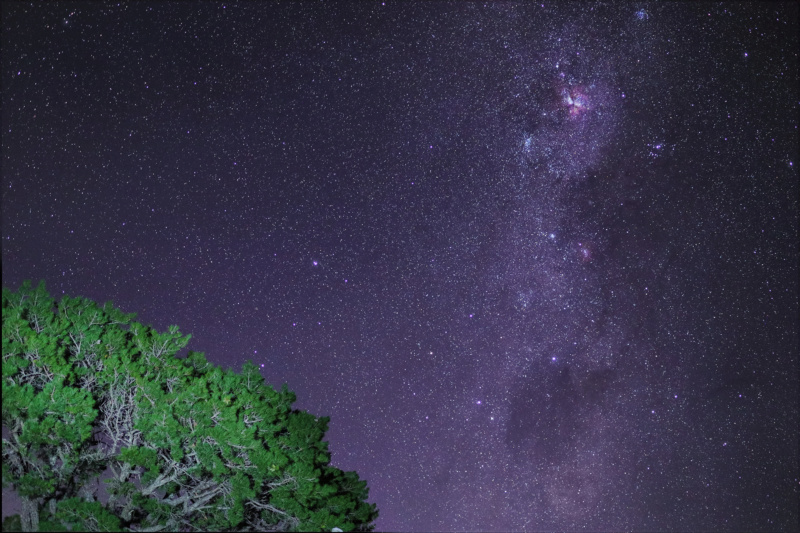
Shooting South for a change with the EOS M6 mirrorless + EF-M 32mm f/1.4 STM - with the NiSi Night Filter and a Daylight White Balance.

Accidental selfie with an 11mm lens (I forgot this lens was so wide). You can see a Celestron LifePo Powertank battery illuminating the ground and powering my lens heater.
The image below isn't ideal but it's my first attempt at properly stacking a larger number of images. But because my computer was almost out of harddrive space (an issue I rectified today), I was forced to cut a lot of corners with this picture. I think that aligning each photograph by hand in Photoshop was made more difficult in that I didn't use a guided EQ mount (computerized tripod) to track the stars so there was a little distortion from one shot to the next. The photographs were about 5 seconds of exposure each. I toned the background of each image and then stacked the images into 4 stacks, each comprised of 20 layered PSD files. I then flattened them and merged the resulting 4 images with just a few minor adjustments to bring out the colors and tone down the blacks a little. It seemed to work but I saved the four PSD stacks and might try to redo this image to even out the star brightness across the image.
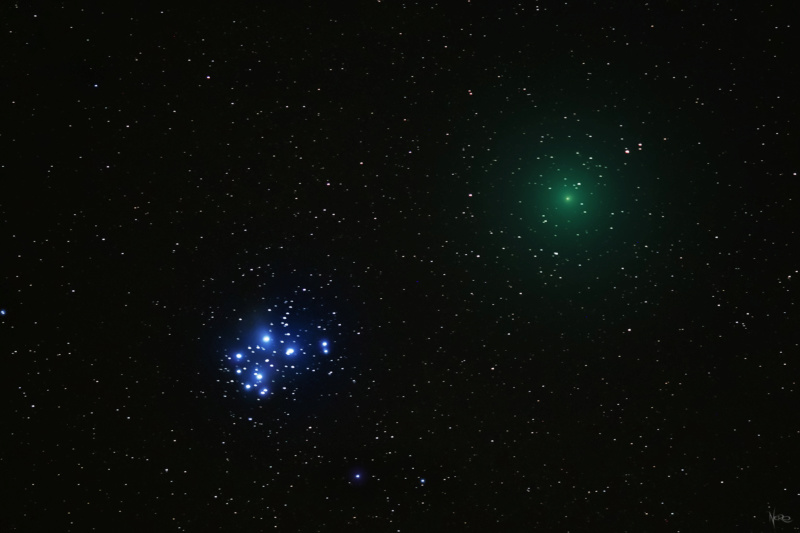
Final image made from 80x stacked & manually aligned photographs. This revealed more subtle detail and reduced noise.
Comet 46P/Wirtanen alongside the Pleiades Constellation (which is back-lighting a dark nebula. Hence the blue glow).
* Taken with the Canon 6D + EF 135mm f/2L USM lens. I might have to redo this one as the stars vary too much in brightness.

nero_design- Contributor Plus

- Number of posts : 2090
Registration date : 2008-11-18
 Re: "Christmas Comet of 2018" (46P/Wirtanen) is visible in the skies now... (PICS)
Re: "Christmas Comet of 2018" (46P/Wirtanen) is visible in the skies now... (PICS)
Really nice astro photography there Nero.
The shot of the Coal Sack shows that it is really not so dark after all with plenty of stars visible inside , although unsure if they are for-ground or back-ground stars?
My shot of Mc Naught was after sunset but with a a strong glow in the sky. I used a Pentax Spot meter to take an exp reading directly off the comet. A great little gadget is the Pentax Spot meter and is way better than any in camera spot meter function that I have used. It is about the same vintage as my 35mm KX.
The Promura Gekkor 135 f1.8 is a nice lens that produces nice sharp contrasty pics for a less known brand and is older than the KX.
Old Faithfull with the 135 and the Spot Meter


The shot of the Coal Sack shows that it is really not so dark after all with plenty of stars visible inside , although unsure if they are for-ground or back-ground stars?
My shot of Mc Naught was after sunset but with a a strong glow in the sky. I used a Pentax Spot meter to take an exp reading directly off the comet. A great little gadget is the Pentax Spot meter and is way better than any in camera spot meter function that I have used. It is about the same vintage as my 35mm KX.
The Promura Gekkor 135 f1.8 is a nice lens that produces nice sharp contrasty pics for a less known brand and is older than the KX.
Old Faithfull with the 135 and the Spot Meter



adrian ss- Contributor Plus

- Number of posts : 4434
Age : 78
Registration date : 2015-07-03
 Similar topics
Similar topics» Sydney GEM Show 2018 - (PICS)
» Comet Leonard In The Southern Hem
» Off Topic..The skies are quiet!!
» Prospecting the Night skies this week...
» Comet Nishimura
» Comet Leonard In The Southern Hem
» Off Topic..The skies are quiet!!
» Prospecting the Night skies this week...
» Comet Nishimura
Page 1 of 1
Permissions in this forum:
You cannot reply to topics in this forum
